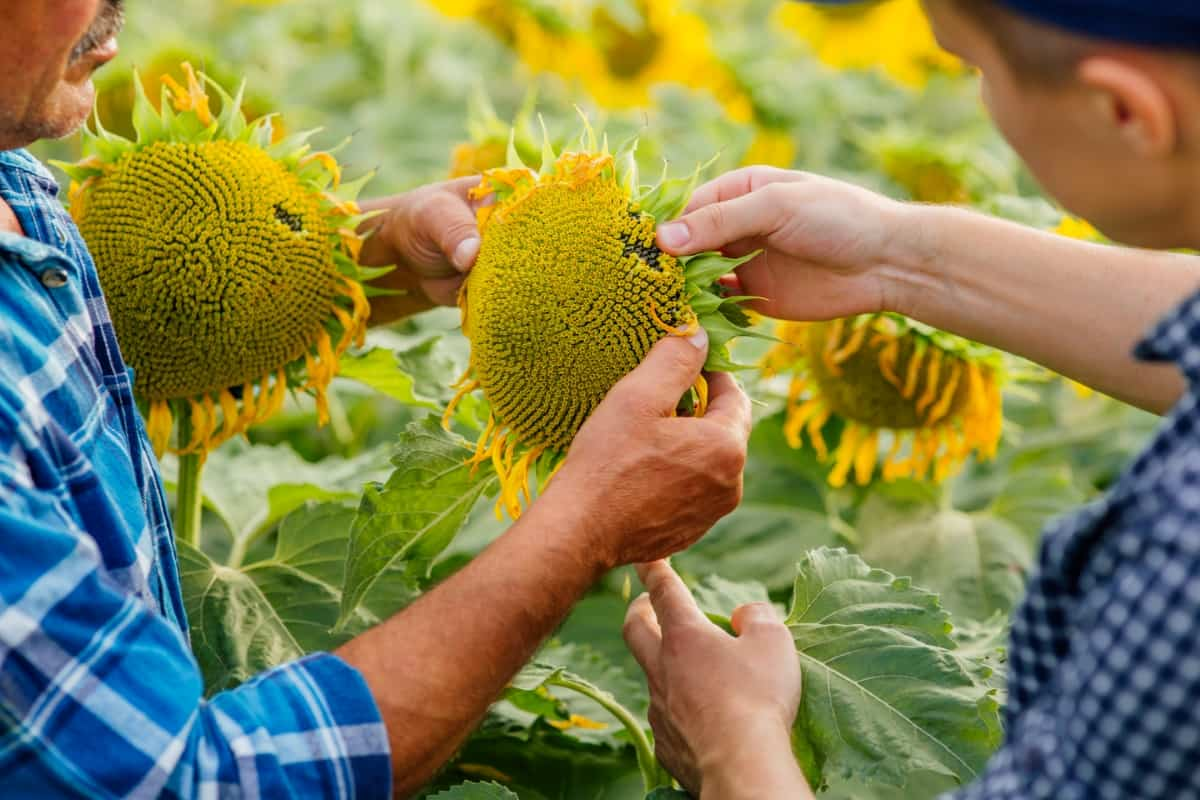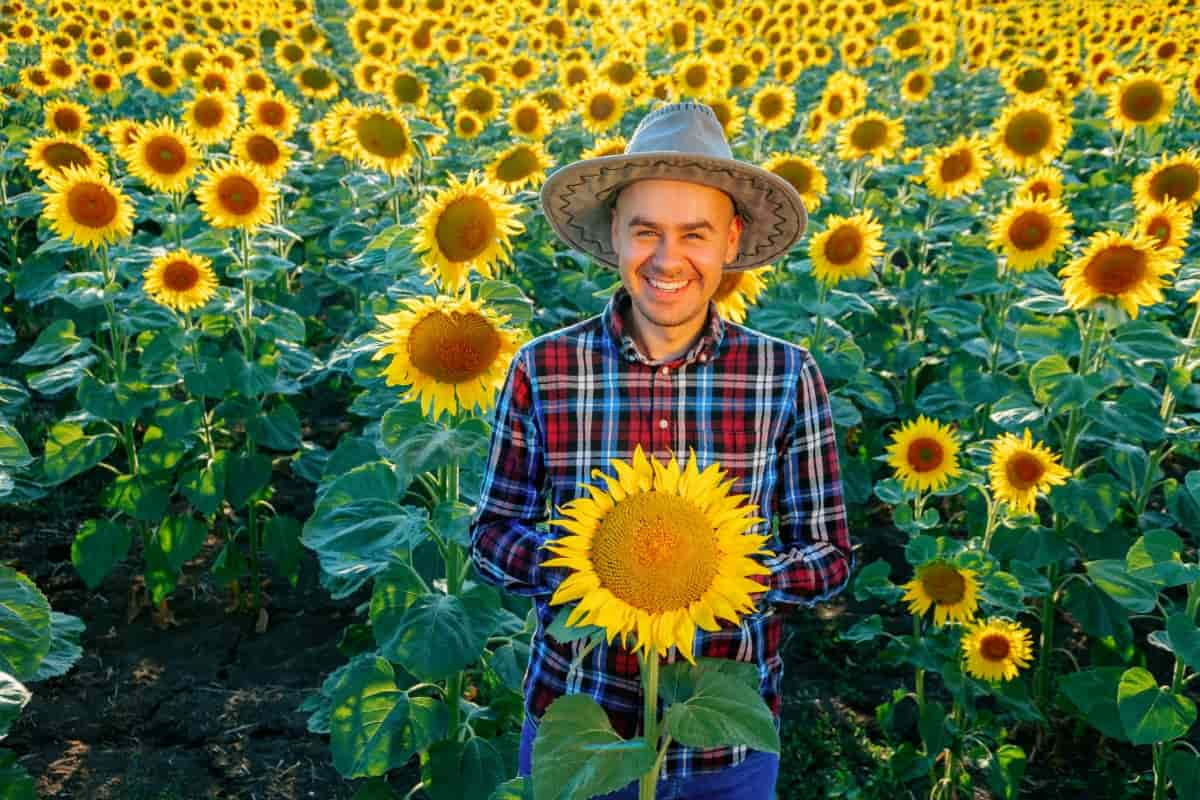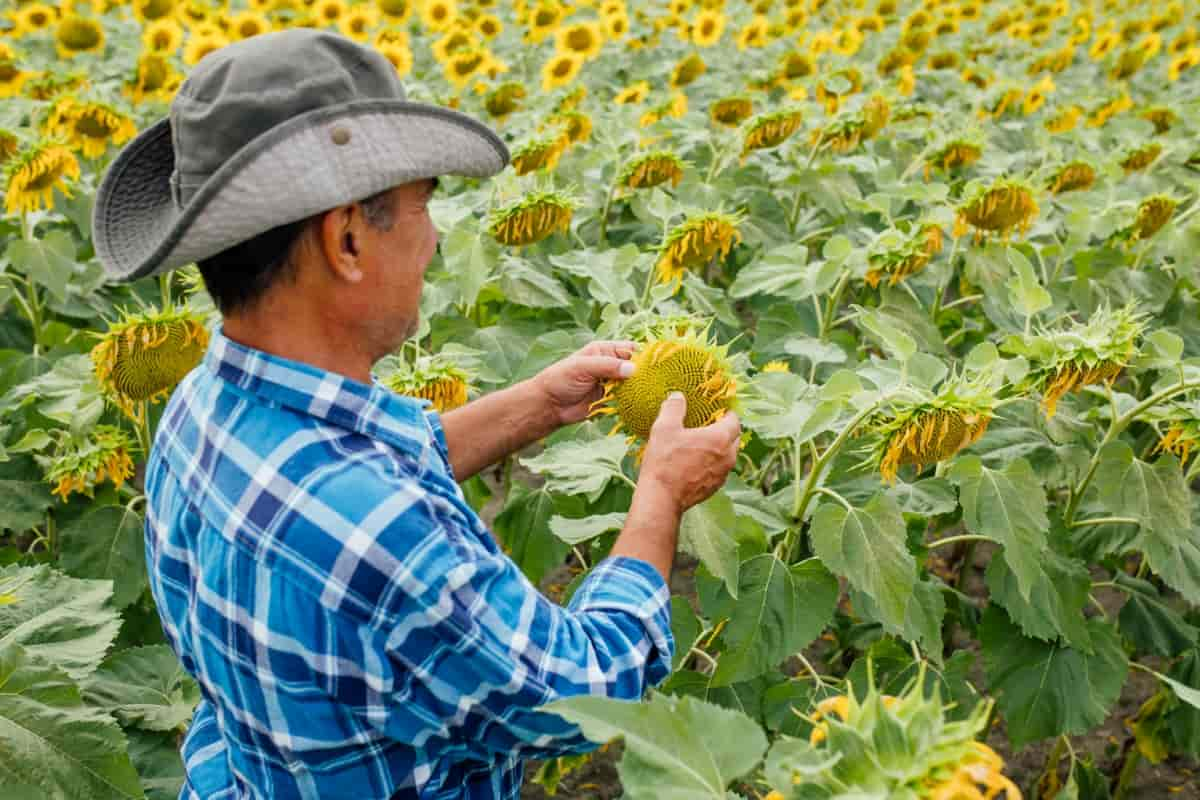The Sunflower, scientifically known as Helianthus annuus L., belongs to the Asteraceae family. It has been cultivated for centuries for various purposes, ranging from ornamental decoration to culinary uses and oil production. Their versatility and adaptability make them a good plant choice for farmers looking to diversify their crops or add aesthetic appeal to their fields.

Sunflower Varieties
The popular variety is the Giant Sungold Sunflower, known for its large blooms and vibrant golden petals that can reach up to 14 inches in diameter. Another favorite is the Velvet Queen Sunflower, with rich burgundy petals that add a dramatic flair to any garden or field. For those looking for a more classic look, the Russian Mammoth Sunflower is a top choice.
With its tall stalks reaching heights of up to 12 feet and traditional yellow petals, this variety never fails to make a statement. Other popular Sunflower varieties include Lemon Queens, Autumn Beauty Sunflowers, and Teddy Bear Sunflowers. Each offers its unique charm and beauty to brighten up any landscape.
Soil Requirements and Preparation
Sunflower plants thrive in well-drained soil with a pH level between 6.0-7.5, rich in organic matter. Before planting Sunflowers, it’s essential to test the soil for nutrient levels and make any necessary adjustments by adding compost or fertilizers to ensure optimal growth. Properly preparing the soil by tilling and removing any debris or weeds will create an ideal environment for Sunflower seeds to germinate. Sunflowers prefer loose, sandy loam soil that allows for good root development and efficient water drainage.
Climate and Environmental Conditions
Sunflowers thrive in warm climates with plenty of sunlight. They are known for their ability to withstand dry conditions, making them a popular crop choice in many regions. Sunflowers require well-drained soil and do best in areas with good air circulation. When selecting a location for your sunflower farm, consider factors like temperature fluctuations and wind patterns. Monitoring weather patterns and adjusting irrigation practices accordingly can help ensure optimal growth for your Sunflowers.
In case you missed it: Best Fertilizer for Sunflower Crop: Organic, NPK, Compost Manure, and Schedule

Seed Selection and Germination
The quality of your seeds will directly impact the overall growth and yield of your Sunflowers. Choose certified Sunflower seeds from reputable suppliers to ensure they are disease-free and have high germination rates. When making your selection, consider factors like seed size, oil content, and resistance to pests. Prioritize hybrid varieties if you’re looking for specific traits like increased yield or disease resistance. Opt for open-pollinated varieties if you want to save seeds for future plantings.
To germinate Sunflower seeds effectively, provide them with adequate moisture, warmth, and oxygen. Sunflower seeds germinate within 7 to 14 days under optimal conditions. Monitor germination progress regularly to identify any issues or delays. Plant the seeds at the recommended depth in well-draining soil and keep them consistently moist until they sprout. Monitor the germination process closely to address any issues promptly and ensure strong seedling development.
Planting Techniques and Spacing
Sunflower seeds should be planted directly into well-prepared soil. The common planting method is direct seeding, which is simple and cost-effective but requires proper soil preparation and weed control. Another approach is transplanting seedlings that have been started indoors. This can help extend the planting season in colder climates and give your Sunflowers a head start on growth. For those looking to maximize space or productivity, square-foot gardening techniques can be employed.
By carefully spacing out seeds within a designated area, you can optimize sunlight exposure and nutrient uptake for each plant. Before planting Sunflower, ensure that the soil is loose and well-drained to promote healthy root development. Planting too closely can result in competition for nutrients and sunlight, leading to stunted growth. On the other hand, planting too far apart can waste valuable growing space.
Sunflowers are typically planted in rows, with a spacing of 12-24 inches between each plant. This allows enough room for the plants to grow and spread out their large root systems. Proper spacing allows each plant to receive adequate resources for optimal growth and flower production. Take time to plan out your planting layout based on the needs of your chosen Sunflower variety.
Irrigation and Water Management
Sunflowers require consistent moisture levels, especially during critical growth stages. Proper irrigation techniques, such as drip or sprinkler systems, can help deliver water efficiently to the plants’ root zones. Monitoring soil moisture levels regularly is essential to prevent overwatering and underwatering.
In case you missed it: Organic Sunflower Production – Cultivation, Farming

It’s important to adjust watering according to weather conditions and plant needs. A well-drained soil structure is vital for preventing waterlogging, which can lead to issues. Water management practices should aim at maximizing water use efficiency while minimizing wastage. By implementing smart irrigation strategies, Sunflower farmers can promote healthy plant development and ultimately increase their crop yields.
Nutrient Management and Fertilization
Sunflowers require specific nutrients to thrive, including nitrogen, phosphorus, and potassium. Before planting, it’s essential to test the soil to determine its nutrient content accurately. Based on the results, you can then tailor your fertilization plan accordingly. Nitrogen is vital for leafy growth in Sunflowers, while phosphorus supports strong root development. Potassium helps with overall Sunflower health and disease resistance. Organic fertilizers can also be beneficial in providing a slow release of nutrients over time. Applying fertilizers at the right time during different growth stages is key to maximizing Sunflower yield.
Weed Control Methods
Weed control is crucial in Sunflower farming to ensure the plants have ample space, nutrients, and sunlight to thrive. There are various methods that farmers can employ to manage weeds effectively without harming the Sunflowers. One common approach is manual weeding, where farmers physically remove weeds by hand or using tools like hoes. This method is labor-intensive but ideal for smaller farms or areas with limited weed infestation.
Another method is mulching, which involves covering the soil around Sunflowers with organic materials like straw or wood chips. The mulch process helps suppress weed growth by blocking sunlight and reducing moisture availability for weeds. Crop rotation is a strategic technique where different crops are grown in succession on the same land. This practice disrupts weed life cycles and reduces their prevalence in Sunflower fields. Using herbicides is a more chemical-based approach to weed control.
Pest and Disease Management
It is crucial in Sunflower farming to ensure a healthy crop. One common pest that affects Sunflowers is the Sunflower moth, which lays eggs on the flower heads. To combat this, regular scouting of the field is important to detect signs of infestation early on. Another pesky pest is the banded Sunflower moth, which feeds on developing seeds inside the head. Implementing proper crop rotation practices can help reduce their populations naturally.
In case you missed it: Sunflower Seed Germination, Time, Temperature, Process

Downy mildew and rust are common diseases in Sunflowers. Proper spacing between plants can promote air circulation, reducing humidity levels that favor these diseases’ development. Using resistant varieties and practicing good sanitation by removing debris from fields after harvest can also help prevent disease outbreaks.
Monitoring Sunflower Growth
Keep a close eye on your Sunflowers’ development from seedling to maturity. Check for nutrient deficiency, pests, or disease signs that could hinder their growth. Regularly inspect the leaves and stems for discoloration or unusual spots. Ensure that your Sunflowers are receiving adequate sunlight and water based on their specific needs.
Monitor the height and overall health of the plants as they grow taller and begin to form buds. Note any changes in flowering patterns and pay attention to how well pollination is occurring within your crop. By staying vigilant throughout the growing season, you can address any issues promptly and maximize your Sunflower yield at harvest time.
Flowering and Pollination
Sunflowers are known for their vibrant yellow petals, which attract bees and other pollinators. As the Sunflower plant grows, it eventually forms flower buds that bloom into beautiful flowers. Pollination plays a major role in the reproduction of Sunflowers. Bees are the primary pollinators for Sunflowers, transferring pollen from one flower to another, which allows fertilization to occur. This process is essential for seed production in Sunflower farming.
Ensuring proper pollination can lead to higher crop yields and healthier plants. Farmers often rely on natural pollinators like bees, but some also use techniques like hand pollination to ensure thorough fertilization.
Flower Boosting Ideas
Try companion planting with beneficial flowers like marigolds or nasturtiums to attract pollinators and deter pests naturally. Adding an organic mulch layer around the base of your Sunflowers can help retain moisture in the soil, promoting healthier blooms. Consider using natural fertilizers to provide essential nutrients without harmful chemicals. Deadheading – removing spent blooms – encourages new flower production, prolonging the blooming period for your Sunflowers.
In case you missed it: Sunflower Cultivation Income, Yield, Project report

Experiment with foliar sprays containing seaweed extracts or fish emulsion to boost plant health and stimulate flowering. Don’t forget about providing adequate sunlight; positioning your Sunflower patch where it receives full sun will ensure optimal growth and abundant blossoms.
Harvesting Sunflowers
Once your Sunflowers have reached maturity, it’s time to harvest them. Harvesting at the right time is crucial for optimal seed production. To check if they are ready, gently press a few seeds – if they’re firm and dark-colored, it’s go-time. To harvest Sunflowers for their seeds, you can cut the heads off with pruning shears or a sharp knife once the back of the flower head turns yellow and begins to dry out.
Hang them upside down in a well-ventilated area to finish drying before extracting the seeds. Leave some heads on the plants after flowering to attract birds that will help with seed removal naturally. For decorative purposes like bouquets or floral arrangements, harvest Sunflowers when fully bloomed but still vibrant in color.
Expected Yield
The yield of Sunflowers can vary depending on various factors such as the variety grown, soil quality, climate conditions, and farming practices implemented. On average, a well-maintained Sunflower field can yield around 1,500 to 2,000 pounds per acre. However, some experienced farmers have reported yields of up to 3,000 pounds per acre with proper care and management.
Post-Harvest Handling and Storage
After the hard work of harvesting Sunflowers, it’s crucial to store them properly for their quality. Post-harvest handling involves removing any debris or damaged flowers to ensure only the best ones are stored. Sunflowers should be dried in a well-ventilated area to prevent mold growth.
Once dried, Sunflowers can be stored in a cool, dry place away from direct sunlight. Proper storage helps retain the seeds’ freshness and nutrients for longer periods. Consider using tight containers or vacuum-sealed bags to prolong shelf life. Check stored Sunflowers regularly for any signs of moisture or pests that could compromise their quality. Monitor temperature and humidity levels in storage areas to prevent spoilage.
Marketing and Selling Sunflower Products
When it comes to marketing and selling Sunflower products, there are various avenues you can explore to reach your target audience. One option is to set up a stand at local farmers’ markets or craft fairs where you can showcase your Sunflower products, such as seeds, oil, or even handmade soaps. Online platforms like social media provide a great opportunity to promote and sell your Sunflower items to a wider audience. Utilize visually appealing photos and engaging content to attract potential customers.
In case you missed it: Sunflower Oil Extraction Process, Methods – A Full Guide

Collaborating with local stores, cafes, or restaurants is another effective way to get your Sunflower products in front of interested buyers. Consider offering samples or hosting special events to create buzz around your offerings. Don’t forget the power of word-of-mouth marketing. Building a strong brand reputation can help drive sales and loyalty in the long run.
Challenges and Future Trends in Sunflower Farming
One challenge faced by Sunflower farmers is the unpredictable weather patterns, which can affect crop growth and yield. Adapting to climate change by implementing sustainable practices will be crucial for the future of Sunflower farming. Another challenge is pest and disease management. Staying up-to-date on effective control methods and investing in preventative measures will be essential to protect Sunflower crops from potential threats.
Additionally, market fluctuations and competition can pose challenges for farmers looking to sell their products at competitive prices. Looking ahead, future trends in Sunflower farming may include advancements in technology, such as precision agriculture tools for improved efficiency and productivity. Sunflower farming can be a rewarding and profitable venture for farmers of all levels. By utilizing different planting techniques, such as direct sowing or transplanting, you can maximize your Sunflower yield.
- Economical Aquaculture: A Guide to Low-Budget Fish Farming
- 15 Common Planting Errors That Can Doom Your Fruit Trees
- How to Make Houseplants Bushy: Effective Tips and Ideas
- Innovative Strategies for Boosting Coconut Pollination and Yield
- Pollination Strategies for Maximum Pumpkin Yield
- The Complete Guide to Chicken Fattening: Strategies for Maximum Growth
- Natural Solutions for Tulip Problems: 100% Effective Remedies for Leaf and Bulb-Related Issues
- Revolutionizing Citrus Preservation: Towards a Healthier, Greener Future
- Natural Solutions for Peony Leaf and Flower Problems: 100% Effective Remedies
- Maximizing Profits with Avocado Contract Farming in India: A Comprehensive Guide
- Natural Solutions for Hydrangea Problems: 100% Effective Remedies for Leaf and Flowers
- The Ultimate Guide to Choosing the Perfect Foliage Friend: Bringing Life Indoors
- From Sunlight to Sustainability: 15 Ways to Use Solar Technology in Agriculture
- The Ultimate Guide to Dong Tao Chicken: Exploring from History to Raising
- The Eco-Friendly Makeover: How to Convert Your Unused Swimming Pool into a Fish Pond
- Mastering the Art of Delaware Chicken Farming: Essentials for Healthy Backyard Flocks
- 20 Best Homemade Fertilizers for Money Plant: DIY Recipes and Application Methods
- How to Craft a Comprehensive Free-Range Chicken Farming Business Plan
- Brighten Your Flock: Raising Easter Egger Chickens for Beauty and Bounty
- How to Optimize Your Poultry Egg Farm Business Plan with These Strategies
- Subsidy for Spirulina Cultivation: How Indian Government Schemes Encouraging Spirulina Farmers
- Ultimate Guide to Raising Dominique Chickens: Breeding, Feeding, Egg-Production, and Care
- Mastering the Art of Raising Jersey Giant Chickens: Care, Feeding, and More
- Ultimate Guide to Raising Legbar Chickens: Breeding, Farming Practices, Diet, Egg-Production
- How to Raise Welsummer Chickens: A Comprehensive Guide for Beginners
- How to Protect Indoor Plants in Winter: A Comprehensive Guide
- Ultimate Guide to Grow Bag Gardening: Tips, Tricks, and Planting Ideas for Urban Gardeners
- Guide to Lotus Cultivation: How to Propagate, Plant, Grow, Care, Cost, and Profit
- Agriculture Drone Subsidy Scheme: Government Kisan Subsidy, License, and How to Apply Online
- Ultimate Guide to Raising Araucana Chickens: Breed Profile, Farming Economics, Diet, and Care
- Bringing Hydroponics to Classroom: Importance, Benefits of Learning for School Students
- Ultimate Guide to Raising Polish Chickens: Breed Profile, Farming Economics, Diet, and Care
- Ultimate Guide to Raising Australorp Chickens: Profile, Farming Economics, Egg Production, Diet, and Care
- Silkie Chicken Farming: Raising Practices, Varieties, Egg Production, Diet, and Care
- Sussex Chicken Farming: Raising Practices, Varieties, Egg Production, Diet and Care
- Homemade Feed Formulations for Livestock: Discover Cost-effective Starter to Finisher Feed Recipes
This servìce ìs very good. Please confirm the optimum spacing for savanàh àreas. Thànk you.
Please how can I get a book for better seed to plant in Tropica area like East Africa.(2). I do thank for all I read here
Great work. Please how do i get seeds for planting in tropical West-Africa, especially the variety- Helianthus annus i.e Common sun flower, you also mentioned the seeds need to be treated with Captan or Ceresan before planting , can you give in detail if you can how it should be done and also if there are other substitute(Captan, Ceresan), so I could go through our local market. Thanks
I am from Jammu and Kashmir I Want To Grow The crop Of Sunflowers
Sir I am from Odisha, the sunflower farming is very popular in our state, also we are farm sunflower in summer. This guide is very helpful for Beginner farmer who want to start sunflower farming as a business purpose.
I NEED INFORMATION ON HOW TO GROW SUNFLOWER. I NEED THE GUIDE.
I am anew small farmer interested in sunflower farm . How do I get information on how go about it ?
Thanks for the clear information .
I am from Meerut district of UP and interested to grow Sunflower during March to May/June and repeat June to September. In fact our land is sandy soil. However, tubewell irrigation is available but no crop is possible during April to September. Please suggest
I am from Ethiopia want to grow sunflower especially the variety Hysun-33, where I get the seed especially if I can get from Sudan/
The document is very informative but l need to know types of fertilizers required and how much per hactare
How much can I get from a hactar?
I would like grow this sunflower crop in my farm from where to buy the seeds and which one are the best seeds available in Maharashtra?